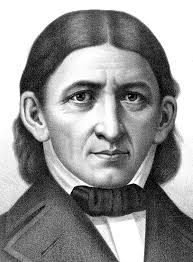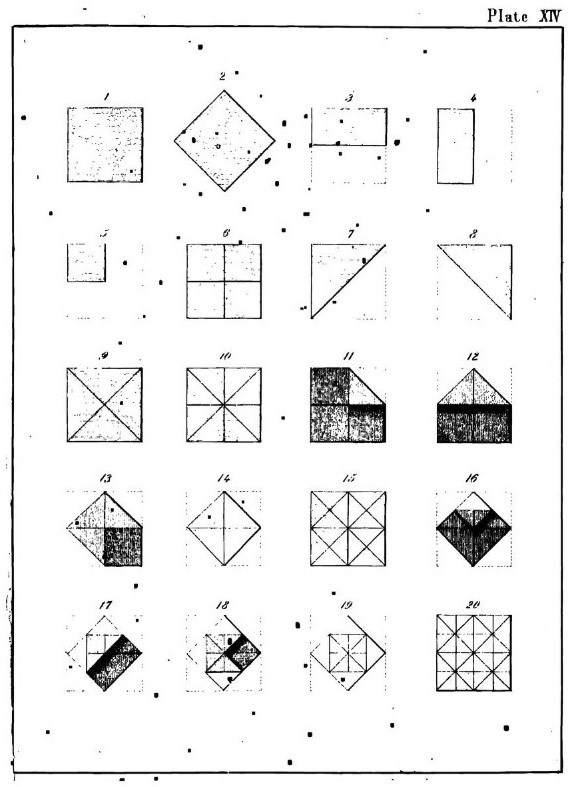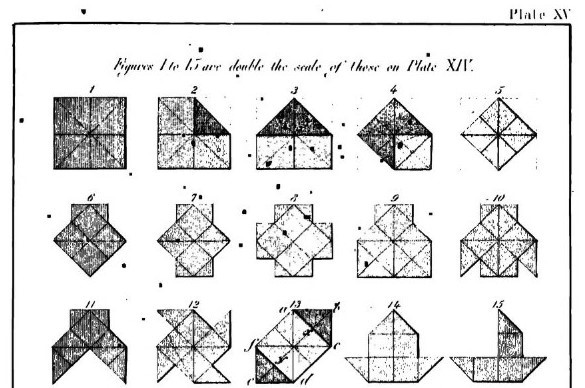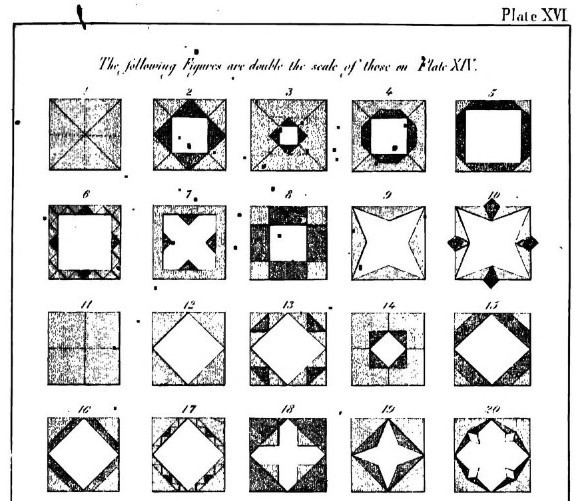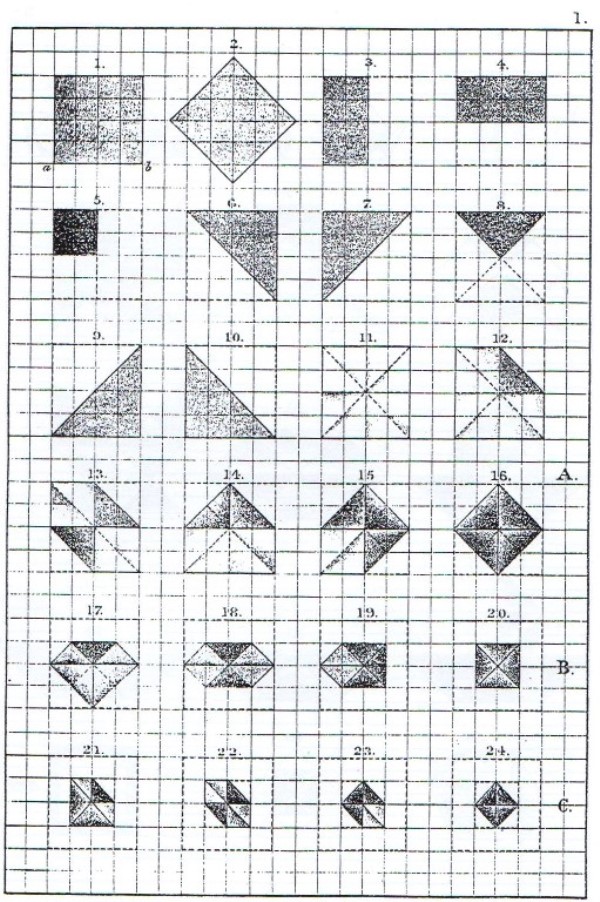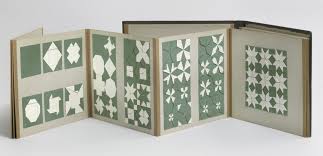| The Public Paperfolding History Project
x |
|||||||
| Froebelian Paperfolding and the Kindergarten - An Overview | |||||||
| This
page records brief notes recording what I have been able
to discover about the use of paperfolding by Friedrich
Froebel and its development within the Kindergarten
movement which he founded. Please contact me if you know
any of this information is incorrect or if you have any
other information that should be added. Thank you. ********** Introduction
Friedrich Froebel, born 1782 and died 1852, was an educationalist from Thuringia, now part of Germany, who developed a theory of education through both teacher directed and self-directed play and founded what became known as the Kindergarten movement. He created a system of 'gifts', objects with which children could play. In the beginning there were just five of these gifts, but, in his later years, Froebel extended his system to include what he called occupations, which differed from the gifts in that the material used in these occupations was changed as it was played with. In this system, 'Falten' or paperfolding, was an occupation in its own right but some element of paperfolding was also an integral part of several other occupations as well. After Frobel's death his followers in various countries added additional occupations to the original list. Some of these additional occupations also include a paperfolding element. It is also important to note that there is little consistency in the names and numberings of the various gifts and occupations across the Froebelian literature. ********** Information about paperfolding from Froebel's own writings 1826 In 1826 Froebel published 'Die Menschenerziehung', in English ''The Education of Man', outlining the principles and methods in use in his school at Keilhau. The 'Education of Man' does not contain an outline of the system of gifts and occupations that later came to characterise the Kindergarten movement. However, in his notes, interpolated into the text of the English translation, which was published by D Appleton and Company, New York in 1908, W N Hailmann states that 'In a weekly journal which Froebel began to publish in 1850, a System of Gifts and Occupations , similar to the one now used in kindergartens is described.' I have not been able to locate the journal entries that Hailmann refers to. ********** 1844 There is mention of a paper windmill on page 83 of 'The Mottoes and Commentaries of Friedrich Froebel's Mother Play', published by D Appleton and Company, New York in 1895, which is a rendering into English of a work by Froebel first published in German in 1844. The English text contains the sentence 'Hearing the sound, out runs a little boy with his paper windmill. It turns faster and faster as he increases his speed.' See The mottoes and commentaries of Friedrich Froebel's Mother Play ********** 1845/7 In his article 'Falling into Disuse: the rise and fall of Froebelian mathematical folding within British kindergartens' (See full article) Michael Freedman quotes two letters written by Froebel, in 1845 and 1847, which refer to paperfolding. Firstly, 'Around July 1845, Froebel writes to Leonhard Woepcke about the transformation of forms via paper folding: [a] further new and great, so entertaining, instructive and useful division of the occupations for the child is the transformation of the forms […] from flexible surfaces, from paper. The breaking and folding of different shapes and objects from one and the same square, or, what is the same: from several evenly sized squares.' Secondly, Froebel also writes to Berthold Auerbach in 1847, including a “folding box” in his description of the occupation materials.' ********** 1874 The main source of information about Froebel's ideas on the use of paperfolding in the kindergarten, however, is to be found in Volume 2 of 'Gesammelte pädagogische Schriften' (Collected Educational Writings), an anthology of Froebel's writings edited by Wichard Lange and published by Enslin in Berlin in 1874. Pages 371–388 contain a section titled 'Anleitung zum Papierfalten. Ein Bruchstück. Eine entwickelnd-erziehende und unterhaltend-belehrende Kinderbeschäftigung für Kinder von 5 bis 7 Jahren und darüber, unter eingehender Mitwirkung von leitenden Erwachsenen' which Friedman translates as 'Instructions for Paper Folding: A Fragment. A Developing-Educating and Entertaining-Instructing Children’s Activity for Children from Five to Seven Years and Over, with the Extensive Participation of Adults'. Friedman dates this fragment to 1850. An English translation of this section can be found as 'Employment of Children - Guide to Paper Folding - A Fragment' on pages 89 - 117 of 'Friedrich Froebel's Education by Development: The Second Part of the Pedagogics of the Kindergarten' translated by Josephine Jarvis and published by D Appleton and Company in New York in 1899, which can be found online here. In this section Froebel first describes how to create a square from any irregular sheet of paper then how to fold and cut four squares from a single rectangular sheet of machine made paper. He then describes a number of simple folds that can be made in the square and the mathematical properties that they demonstrate. ********** Paperfolds attributed to Froebel by later writers 1877 In the second part of her book 'Kindergarten Practice', probably first published in London in 1877 by A N Myers and Co, which is a substantially abridged version, in two parts, of 'Die Praxis Des Kindergartens' by Auguste Koehler, Mary Gurney attributes several of the paperfolds shown in the illustrations to Froebel himself. (I have not found this information in Koehler's original book.) These attributions are: All the paperfolds shown in Plate XIV which include the single and doubly blintzed groundforms (figs 14 and 19):
*** The first 15 forms of life shown in Plate XV:
*** The first 20 forms of beauty shown in Plate XVI:
********** 1895 Eleenore Heerwart, writing in her 'Course in Paperfolding - One of Froebel's Occupations for Children', first published in 1895, says (from section 9 of her book) 'Froebel has described the first folds fully in his work ... never thinking how far these few hints would lead to in the course of years.' The first folds in question are the singly blintzed, doubly blintzed and triply blintzed groundforms.
********** Developments after Froebel's death in 1852 Many of Froebel's followers wrote practical handbooks setting out how the various gifts and occupations could be used in the context of the kindergarten. Many of these, though not all, included paperfolding, under various guises, not only in the main chapters / sections of these handbooks dealing with 'Falten' (or pure paperfolding) from squares, rectangles, triangles and other shapes, including circles, but also in other chapters / sections about paper weaving, paper cutting, and the folding and interlacing of paper strips. Details of the contents of many of these manuals can be found on the main Sources page of this site. Within these manuals the 'Falten' occupation is usually divided into three distinct categories, for which I shall use the terms Forms of Truth (simple mathematical folds), Forms of Beauty (flat geometrical patterns folded from squares and other shapes), and Forms of Life (representations of everyday objects), although these names are not used consistently across the Froebelian literature. It is likely that these categorisations originated with Froebel himself. Forms of truth / folds of knowledge These were geometrical paperfolds intended to impart mathematical understanding and knowledge and can be very simple, or quite sophisticated. I have not made a detailed study of this category of paper folds. In 1893 Tandalam Sundara Rao's book 'Geometrical Exercises in Paperfolding', which took this category of paperfolds to a new level, was published in Madras, India, by Addison and Co. In his Introduction Rao acknowledges that 'The idea of this book was suggested to me by Kindergarten Gift No. VIII - Paper-folding.' Forms of beauty These were geometrical paperfolds that seem to have been intended to foster creativity and the appreciation of symmetry as a source of beauty. I have not made a detailed study of this category of paper folds. The original forms of beauty were mainly square symmetric patterns developed from the blintzed square or the windmill base, usually without the use of cuts, but as time went by other starting shapes were used and the use of cuts seems to have become more frequent. These paperfolds were also used as tiles to create larger patterns. Many albums collecting together forms of beauty can be found in museums and collections all over the world.
Album containing Folds of Beauty folded by Fannie E Kacline c 1890 in the collection of MOMA, Mew York Forms of Life These were paperfolds that were designed as / could be interpreted as day to day objects that children would be familiar with and were used in conjunction with appropriate stories and songs. Froebelian education lays emphasis on originality and creativity and encourages children to find things out for themselves. Froebelian paper folding was therefore exploratory as well as didactic. The possibilities inherent in the various basic configurations of the paper were explored and new forms were discovered. These were named and passed on and became an intrinsic part of the repertoire of kindergartens across the world. It is difficult to track this development and dissemination, which probably took place largely by word of mouth, but was occasionally recorded in books. ********** The Kindergarten throughout the world Froebelian-style kindergarten education spread throughout the world after Frobel's death. It was particularly influential in Western Europe (though not in France), the United States, Argentina, China and Japan, though in many other countries as well. It would be useful to trace the development of the use of paperfolding in each of these countries separately, but that is beyond the scope of this project at present. There is, however, some limited information on the history of paperfolding within kindergarten education on the pages providing overviews of paperfolding in China and Japan. ********** Paperfolding vs Cardboard Modelling / Paper Sloyd In the English speaking world, particularly in England itself and in the USA, paperfolding as an occupation was eventually displaced, in the first quarter of the 20th Century, by Cardboard Modelling and Paper Sloyd. More information about this decline in the use of paperfolding per se in primary schools will be added here as it becomes available. ********** |
|||||||
